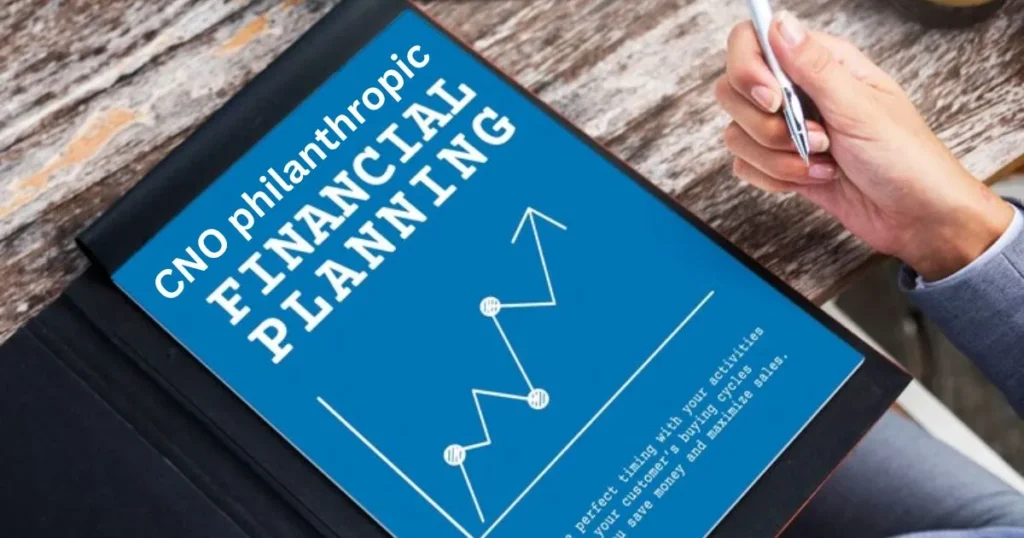Ever wondered how to make your money work for good without breaking the bank? You’re not alone. Many folks struggle to balance their financial goals with their desire to give back. That’s where CNO philanthropic financial planning comes in.
Let’s dive into this game-changing approach that’s helping people and businesses make a difference while staying financially savvy.
What is CNO Philanthropic Financial Planning?
Picture this: you’re managing your wealth, but instead of just focusing on personal gain, you’re also thinking about how to support causes close to your heart. That’s CNO philanthropic financial planning in a nutshell.
It’s a smart way to blend personal financial stability with charitable giving. Think of it as killing two birds with one stone – you’re securing your financial future while making the world a better place.
This approach isn’t just for individuals. Businesses are jumping on board too, seeing it as a way to boost their corporate social responsibility (CSR) efforts.
Why is CNO Philanthropic Financial Planning Important?
You might be thinking, “Why bother with all this planning? Can’t I just donate when I feel like it?” Sure, you could. But here’s why CNO philanthropic financial planning is a game-changer:
It helps you make a bigger impact. By planning your giving, you can direct your money to where it’s needed most. It’s like being a superhero with a strategy.
You’re not putting your financial future at risk. This approach ensures you’re giving within your means. No more worrying about whether that donation will affect your retirement plans.
Tax benefits, anyone? Strategic giving can lead to some sweet tax deductions. It’s like the government is giving you a high-five for your generosity.
You’re building a legacy. This isn’t just about giving now – it’s about creating a lasting impact that continues even after you’re gone.
For businesses, it’s a reputation booster. Companies that give back are often seen in a more positive light. It’s good for the soul and good for business.
Key Benefits of CNO Philanthropic Financial Planning
- Tax Deductions
Let’s talk money. One of the biggest perks of CNO philanthropic financial planning is the potential for tax savings. When you donate to qualified charities, you could be eligible for some juicy tax deductions.
For businesses, this can mean significant cuts in corporate tax bills. It’s like the financial equivalent of having your cake and eating it too – you’re doing good and saving money.
- Aligning Donations with Personal or Corporate Values
Ever felt like your donations weren’t really making the impact you wanted? CNO philanthropic financial planning helps you fix that. It’s all about matching your giving with what matters most to you.
If you’re passionate about education, your plan could focus on supporting schools or literacy programs. For businesses, it might mean backing causes that align with your company’s mission. It’s about making your giving more meaningful and impactful.
- Structured and Sustainable Giving
Gone are the days of random, sporadic donations. CNO philanthropic financial planning is all about creating a structured approach to giving. Whether it’s through regular donations, setting up a donor-advised fund, or creating a charitable trust, you’re building a sustainable way to give.
This structure is especially crucial for businesses looking to make philanthropy a core part of their strategy. It’s about creating long-term relationships with charities and making a lasting difference.
- Improved Public Image and Employee Engagement
For businesses, CNO philanthropic financial planning can be a real image booster. Today’s consumers are savvy – they prefer brands that give back to society. It’s like free advertising, but better because you’re actually doing good.
But it’s not just about customers. Employees love working for companies that care. It boosts morale, increases productivity, and can even help with recruitment. It’s a win-win situation.
- Creating a Lasting Legacy
Here’s where things get really exciting. CNO philanthropic financial planning isn’t just about the here and now – it’s about creating a legacy that lives on long after you’re gone.
By setting up things like charitable trusts or endowments, you’re ensuring that your generosity continues to make waves for generations to come. It’s like planting a tree whose shade you might never sit in, but future generations will enjoy.
How CNO Philanthropic Financial Planning Works

Ready to get started? Here’s a breakdown of how CNO philanthropic financial planning works:
- Assess Your Financial Situation
First things first – you need to know where you stand financially. This means taking a good, hard look at your assets, income, debts, and future financial goals.
For businesses, it’s about analyzing cash flow, profit margins, and long-term financial strategies. The goal? Figure out how much you can give without putting your financial stability at risk.
- Identify Causes You Care About
Next up, it’s time to soul-search. What causes really light your fire? Whether it’s fighting climate change, supporting local arts, or tackling hunger, the key is to choose causes that resonate with your values.
For businesses, this means aligning charitable efforts with your company’s mission and values. It’s about finding that sweet spot where your giving can make the most impact.
- Set a Budget for Giving
Now that you know your financial situation and what causes you want to support, it’s time to crunch some numbers. How much can you realistically give?
For individuals, this means setting a giving budget that doesn’t compromise your financial security. For businesses, it’s about creating a structured giving plan that aligns with your overall financial strategy.
- Choose the Right Philanthropic Strategy
Here’s where things get interesting. There are several ways to approach philanthropic giving:
Donor-Advised Funds (DAFs): Think of these as charitable savings accounts. You contribute money, get an immediate tax deduction, and then decide later which charities to support.
Charitable Trusts: These can provide income to you or your beneficiaries while also supporting your chosen charities.
Direct Giving: Sometimes, the simplest approach is best. This involves making donations directly to charities, either as one-off gifts or regular contributions.
Endowments: These are like gifts that keep on giving, providing long-term support to specific organizations or causes.
- Consult with a Financial Planner
Don’t go it alone. A financial planner who specializes in CNO philanthropic financial planning can be your secret weapon. They can help you navigate the complexities of tax laws, choose the right giving strategies, and ensure your plan aligns with your overall financial goals.
- Monitor and Adjust Your Plan
Your CNO philanthropic financial plan isn’t set in stone. Life changes, financial situations shift, and the needs of charities evolve. Regularly review and adjust your plan to ensure it continues to meet your goals and make the impact you want.
Common Mistakes in CNO Philanthropic Financial Planning
Even with the best intentions, it’s easy to stumble. Here are some common pitfalls to watch out for:
Giving too much, too soon: In the excitement of giving, some folks overcommit and put their own financial security at risk. Remember, sustainable giving is key.
Neglecting to align donations with values: Don’t just give for the sake of giving. Make sure your donations reflect what truly matters to you.
Forgetting about tax implications: Don’t miss out on potential tax benefits. A little planning can go a long way in maximizing the impact of your giving.
Failing to research charities: Not all charities are created equal. Do your homework to ensure your money is being used effectively.
CNO Philanthropic Financial Planning for Businesses
For businesses, CNO philanthropic financial planning isn’t just about doing good – it’s smart business strategy. Here’s why:
Enhanced corporate reputation: Showing genuine commitment to social causes can boost your brand image and customer loyalty.
Improved employee engagement: Employees love working for companies that care. It can boost morale, productivity, and even help with recruitment.
Stronger community relations: By supporting local causes, businesses can strengthen their ties with the community, potentially leading to new opportunities.
Competitive advantage: In a world where consumers increasingly value social responsibility, a strong philanthropic strategy can set you apart from competitors.
Getting Started with CNO Philanthropic Financial Planning
Ready to dip your toes into CNO philanthropic financial planning? Here are some steps to get you started:
Educate yourself: Read books, attend webinars, or take courses on philanthropic planning.
Start small: You don’t need to be a millionaire to start. Even small, regular donations can make a difference.
Talk to a professional: A financial advisor or philanthropic consultant can help you create a plan tailored to your needs.
Involve your family or team: If you’re a business owner, get your employees involved. If you’re an individual, consider making it a family affair.
Stay flexible: Remember, your plan can evolve as your circumstances change.
Maximizing Impact: Advanced Strategies in CNO Philanthropic Financial Planning
Now that we’ve covered the basics, let’s dive into some advanced strategies to really amp up your philanthropic game.
Leveraging Non-Cash Assets

Ever thought about donating more than just cash? Here’s where it gets interesting. You can donate stocks, real estate, or even valuable collectibles. Sometimes, this can be even more tax-efficient than giving cash. Plus, it’s a great way to make a bigger impact without affecting your day-to-day finances.
For businesses, this could mean donating excess inventory or unused equipment. It’s a win-win – you’re clearing out space and making a difference at the same time.
Impact Investing: Aligning Investments with Philanthropy
Here’s a mind-bender: What if your investments could do good while making you money? That’s the idea behind impact investing. It’s about putting your money into companies or funds that align with your philanthropic goals.
For example, if you’re passionate about clean energy, you might invest in renewable energy companies. You’re potentially earning returns while supporting causes you care about. It’s like having your cake and eating it too!
Engaging the Next Generation
If you’re thinking long-term (and you should be), consider how to involve your kids or younger employees in your philanthropic efforts. It’s not just about leaving a legacy – it’s about creating a culture of giving that lasts for generations.
For families, this might mean setting up a family foundation where everyone has a say. For businesses, it could involve creating employee-led giving committees. It’s a great way to foster a sense of purpose and community.
Measuring and Communicating Impact
In today’s data-driven world, it’s not enough to just give – you need to show the impact of your giving. This is where impact measurement comes in. It’s about tracking and communicating the real-world effects of your donations.
For businesses, this can be a powerful marketing tool. Sharing stories of how your company’s giving has made a difference can boost your brand and inspire others to give.
Collaborative Philanthropy: Joining Forces for Greater Impact

Sometimes, the biggest problems need big solutions. That’s where collaborative philanthropy comes in. It’s about joining forces with other donors or businesses to tackle major issues.
This could mean pooling resources to fund larger projects or sharing expertise to address complex social problems. It’s a great way to make a bigger splash with your giving.
Staying Flexible in Your Giving Strategy
The world changes fast, and your giving strategy should be able to keep up. Build flexibility into your plan so you can respond to urgent needs or new opportunities as they arise.
This might mean setting aside a portion of your giving budget for unexpected causes or regularly reviewing and adjusting your philanthropic priorities.
Overcoming Common Challenges in CNO Philanthropic Financial Planning
Let’s face it – even with the best intentions, philanthropic planning can be tricky. Here are some common hurdles and how to clear them:
Analysis Paralysis: With so many worthy causes out there, it’s easy to get overwhelmed. Start by focusing on one or two areas that really resonate with you. You can always expand later.
Balancing Heart and Head: It’s great to be passionate about giving, but don’t let emotions override good financial sense. That’s where a solid plan comes in handy.
Dealing with Family Dynamics: If you’re involving family in your giving, disagreements can arise. Set clear ground rules and decision-making processes from the start.
Measuring Intangible Impact: Some benefits of giving, like improved community relations, can be hard to quantify. Don’t discount these just because they’re not easily measured.
The Role of Technology in CNO Philanthropic Financial Planning
Technology is reshaping how we approach philanthropy. Here’s how you can leverage it:
Online Giving Platforms: These make it easier than ever to find and support causes you care about.
Blockchain for Transparency: This technology can help track donations and ensure they’re used as intended.
AI for Impact Prediction: Artificial intelligence can help predict which interventions are likely to have the biggest impact.
Virtual Reality for Donor Engagement: VR can provide immersive experiences that connect donors more deeply with causes.
The Future of CNO Philanthropic Financial Planning

As we wrap up, let’s gaze into the crystal ball. What might the future hold for CNO philanthropic financial planning?
Increased Focus on Systemic Change: We might see a shift from addressing symptoms to tackling root causes of social issues.
Rise of Micro-Philanthropy: Technology is making it easier for everyone, not just the wealthy, to engage in strategic giving.
Greater Integration with Business Strategy: For companies, philanthropy may become even more closely tied to core business goals.
Emphasis on Local Giving: There could be a renewed focus on supporting local communities and grassroots initiatives.
Read Also: Investing Wisely: A Deep Dive into Money 6X REIT Holdings
FAQ’s
What is CNO philanthropic financial planning?
CNO philanthropic financial planning is a strategic approach to managing wealth that combines personal financial stability with charitable giving. It helps individuals and businesses make impactful donations while maintaining their financial security.
How can CNO philanthropic financial planning benefit me or my business?
It offers tax deductions, aligns donations with your values, and creates a lasting legacy. For businesses, it enhances corporate reputation, improves employee engagement, and strengthens community relations.
What are some common strategies used in CNO philanthropic financial planning?
Popular strategies include donor-advised funds, charitable trusts, and direct giving. Impact investing and non-cash asset donations are also advanced techniques used to maximize philanthropic impact.
Final Words
Ever wondered how to make a difference without breaking the bank? That’s where CNO philanthropic financial planning comes in. It’s a smart way to balance your giving with your financial goals.
Here’s the deal: you figure out what causes you care about, set a giving budget, and choose how to donate. It could be through special funds, trusts, or direct giving. The best part? You might save on taxes too.
For businesses, it’s a win-win. You boost your reputation and keep employees happy while doing good.
Remember, start small, stay flexible, and don’t be afraid to ask for help. With CNO philanthropic financial planning, you can make a lasting impact and feel good about your finances. Pretty cool, right?

I manage KickyReport.com, a news-driven platform where I deliver timely updates. My focus is on keeping readers informed about the latest events and trends.
